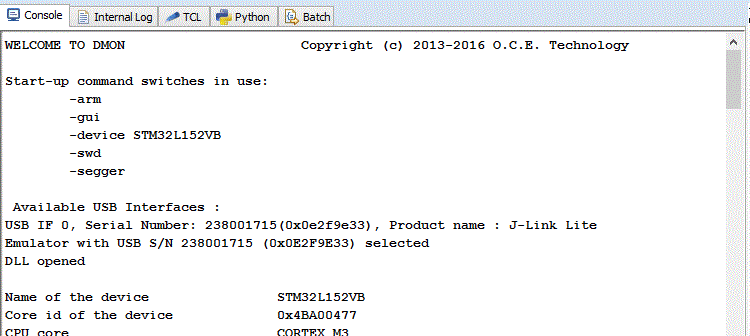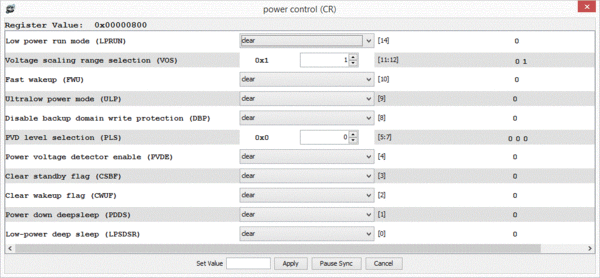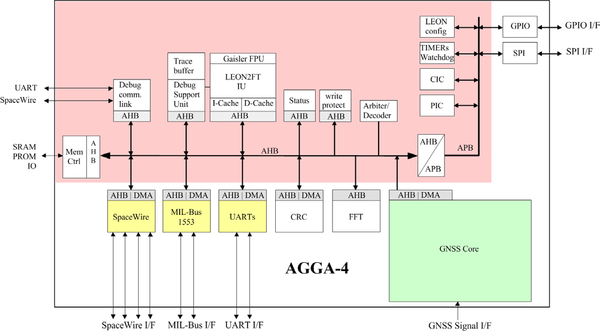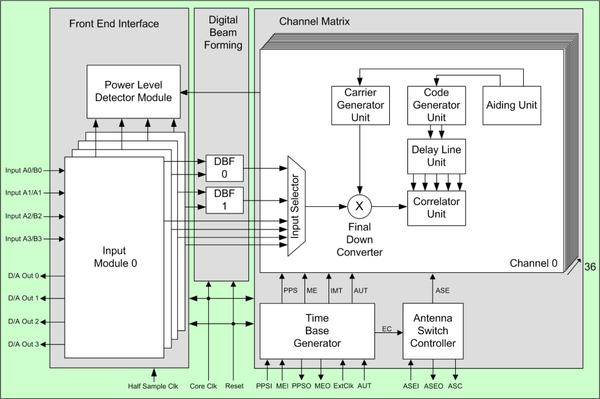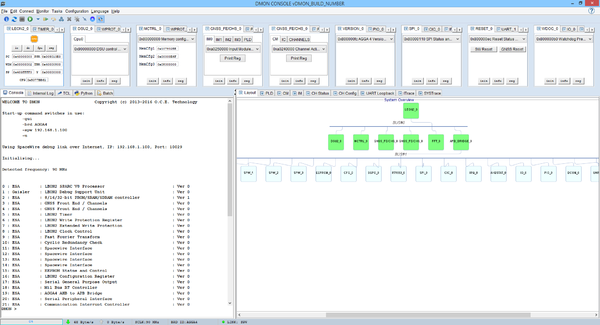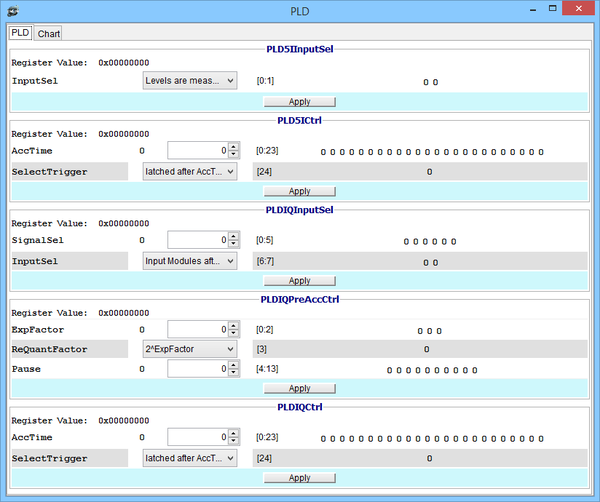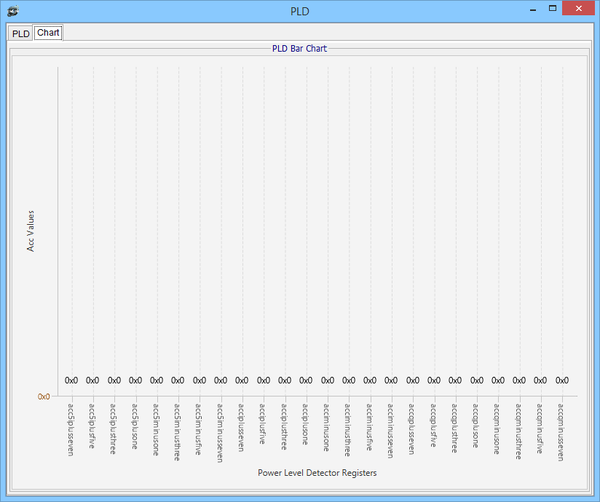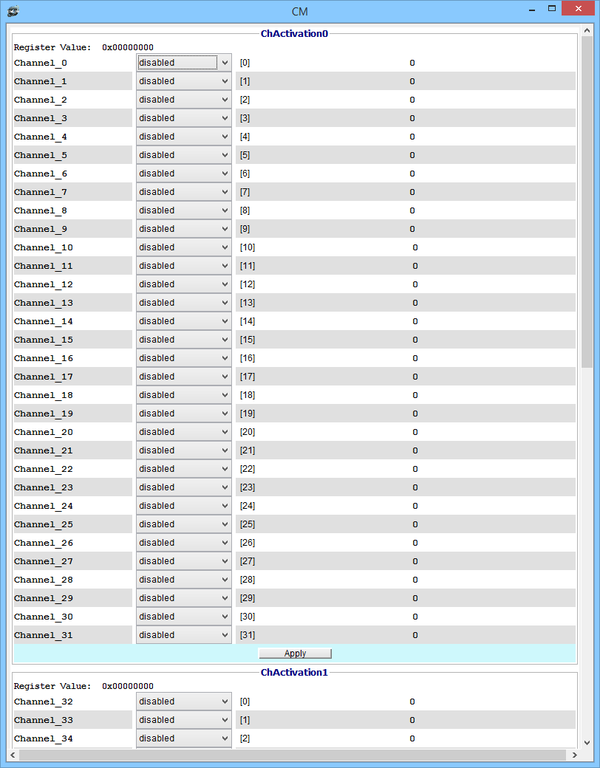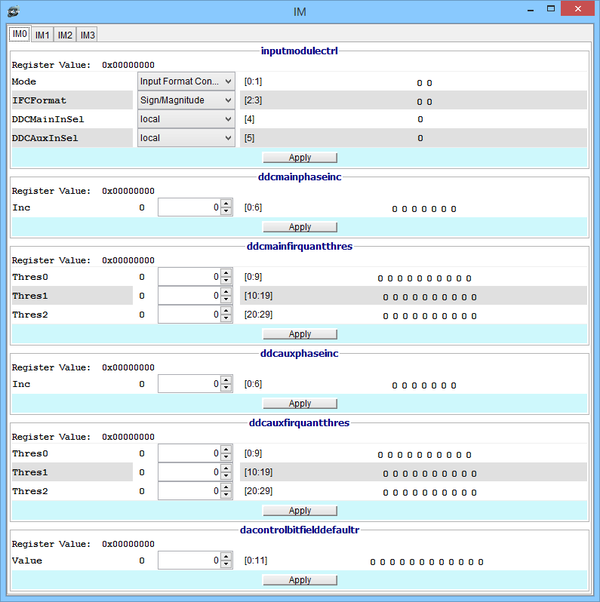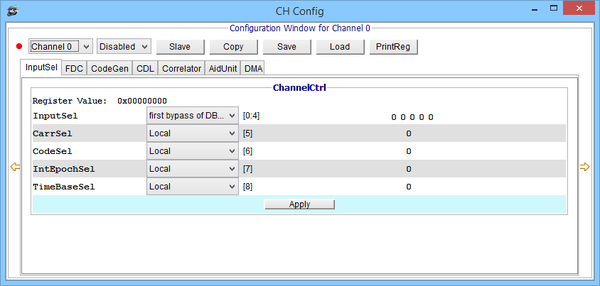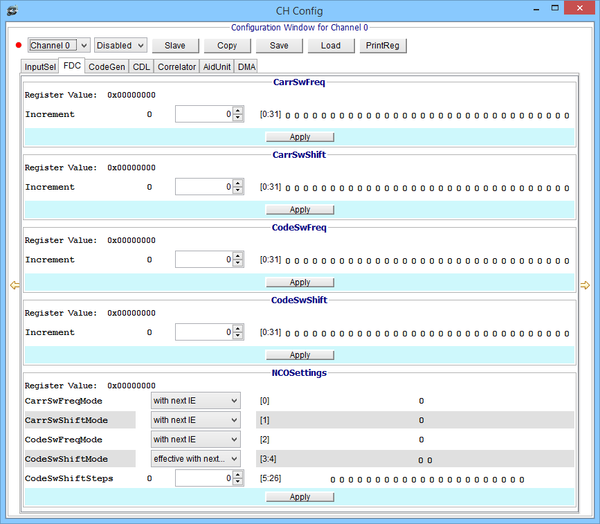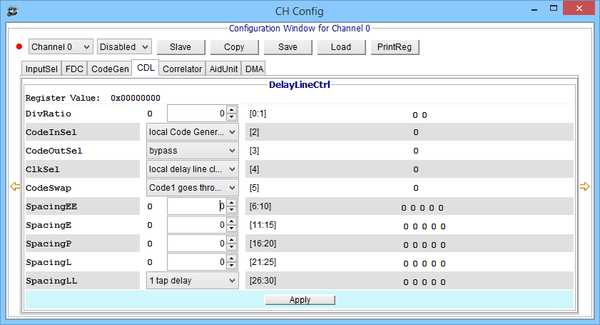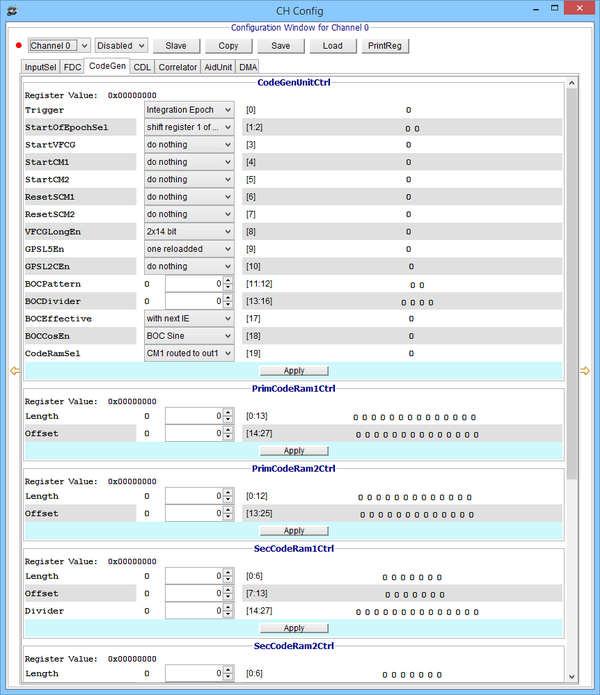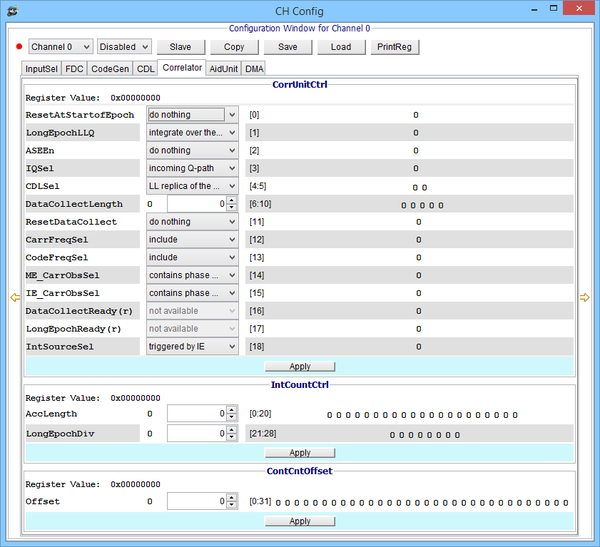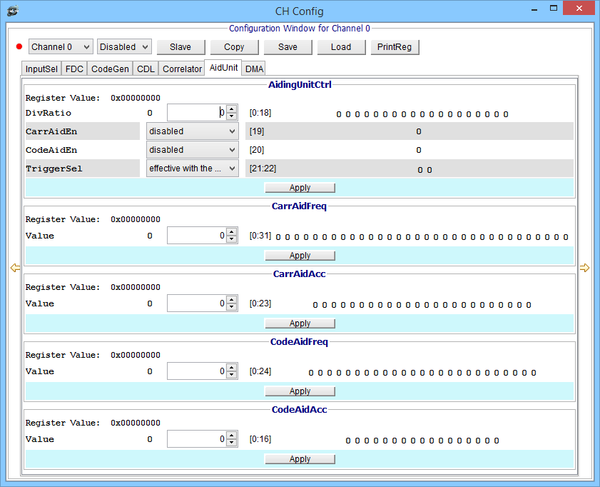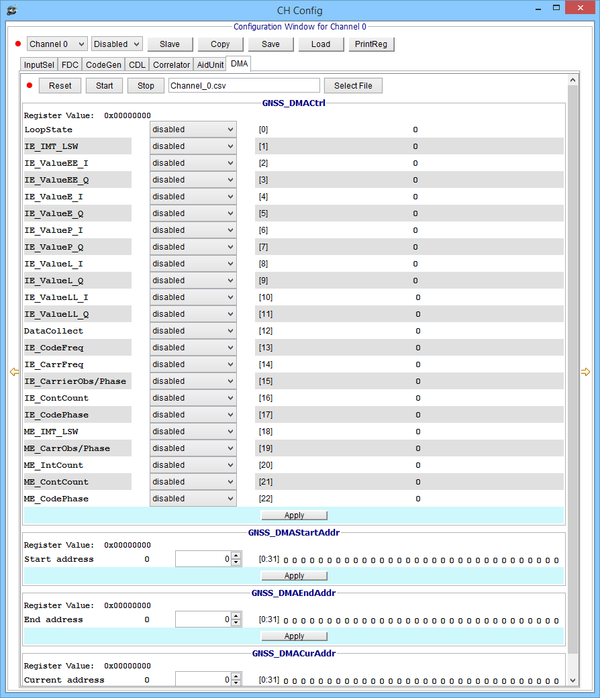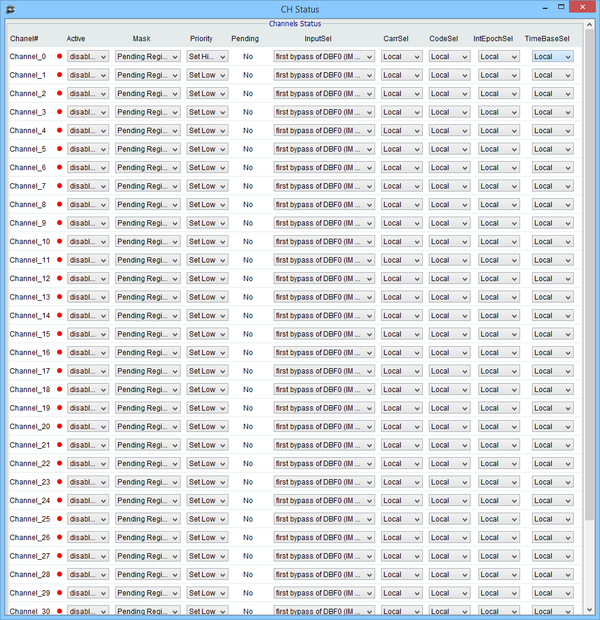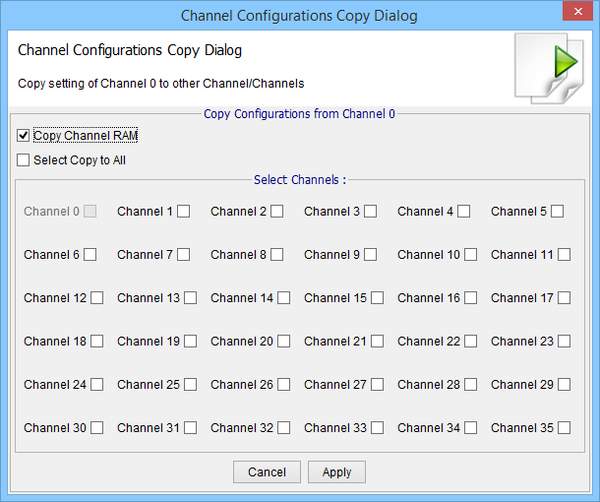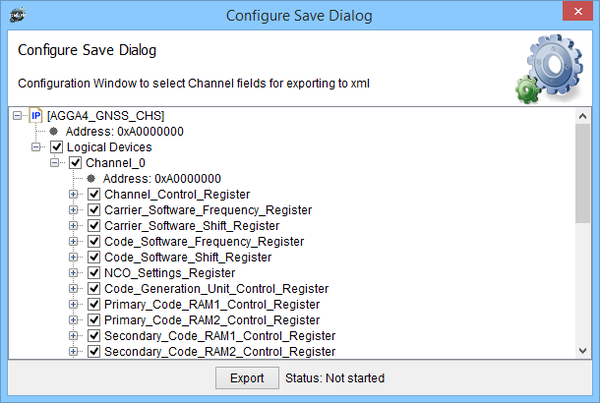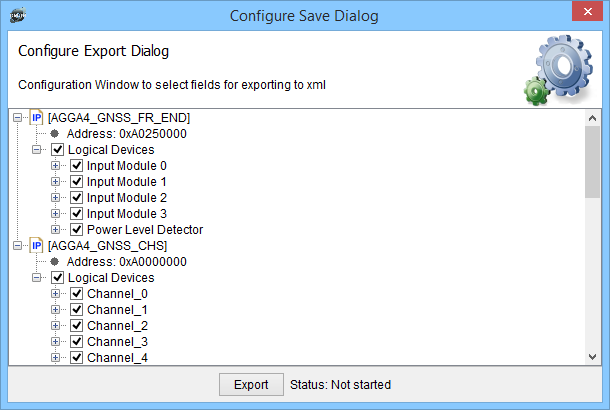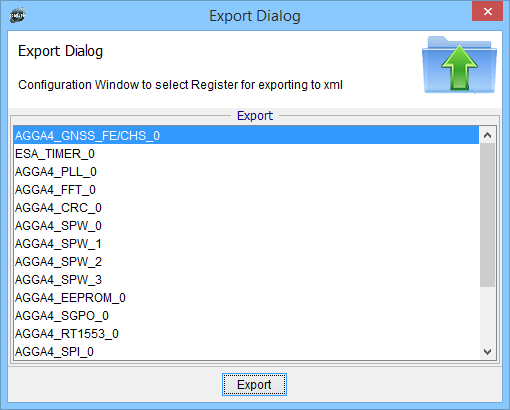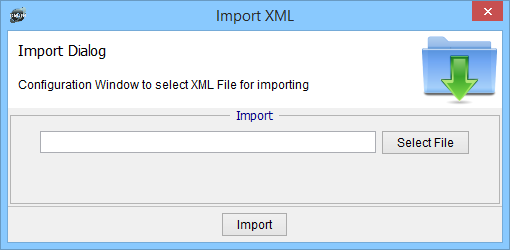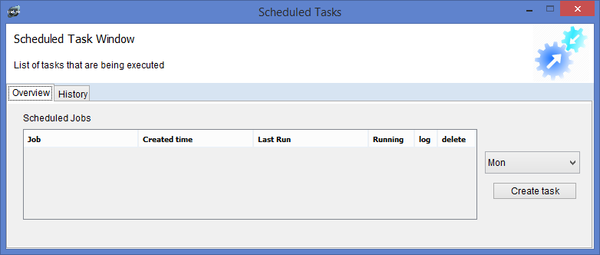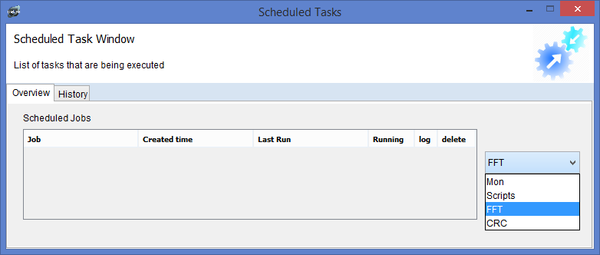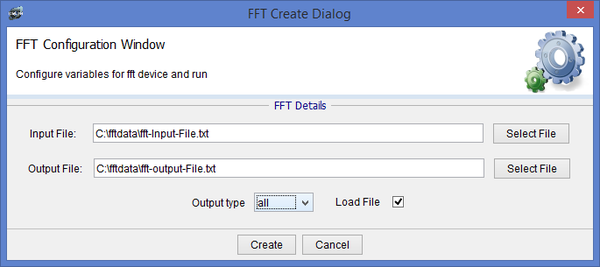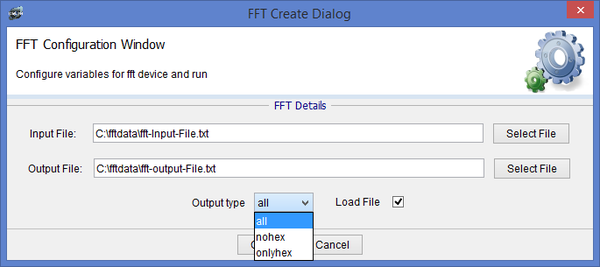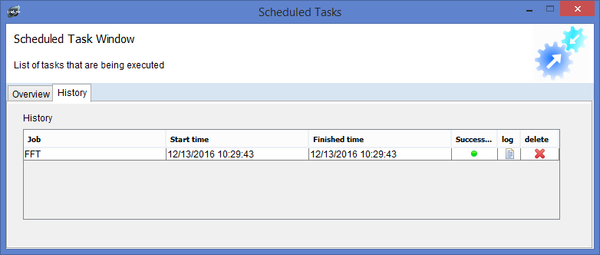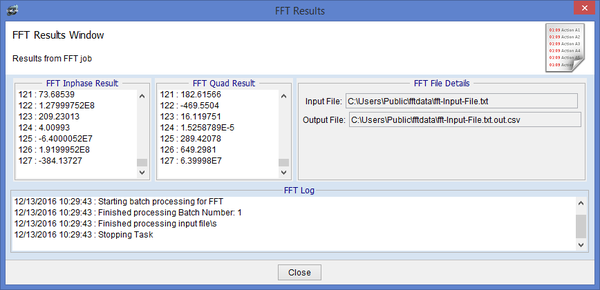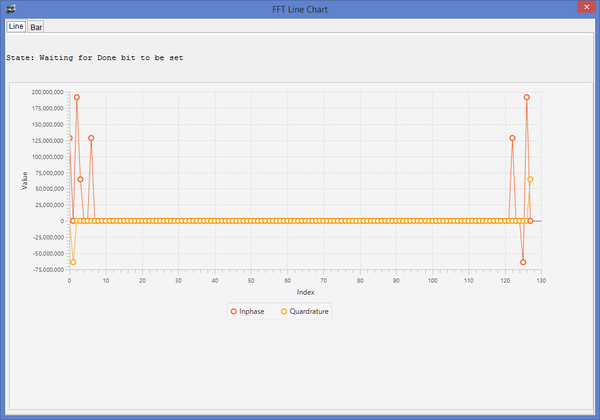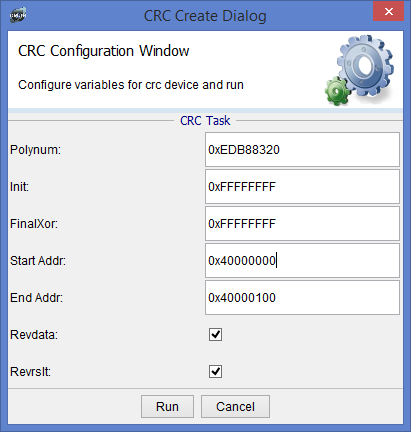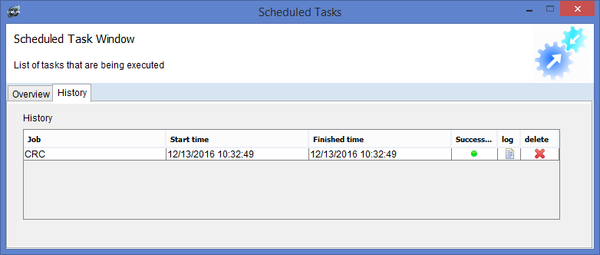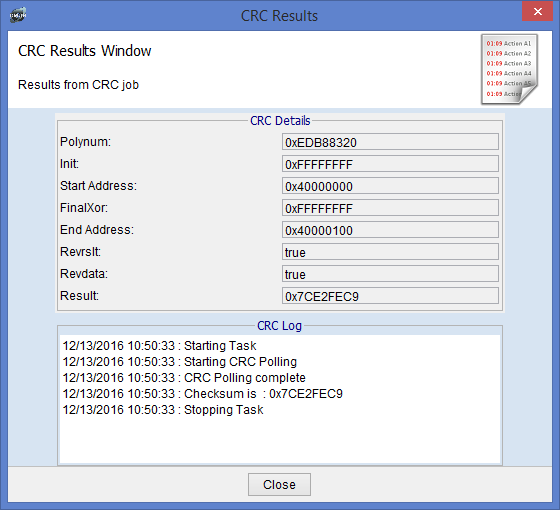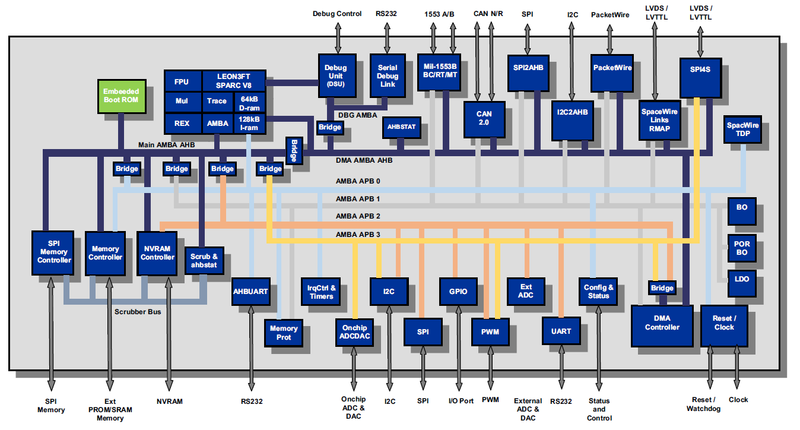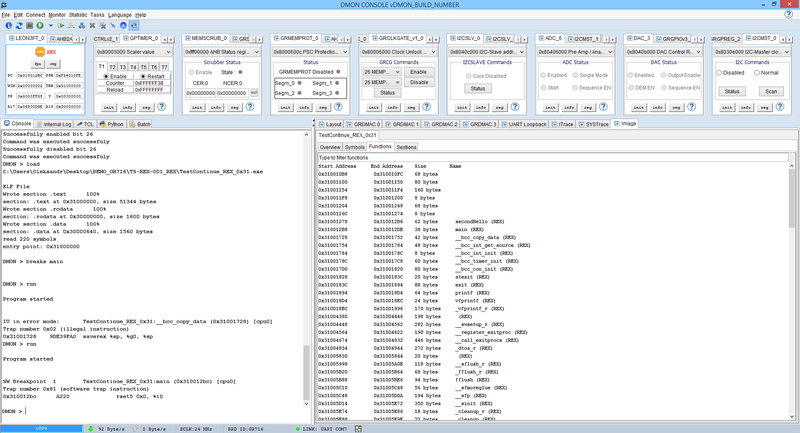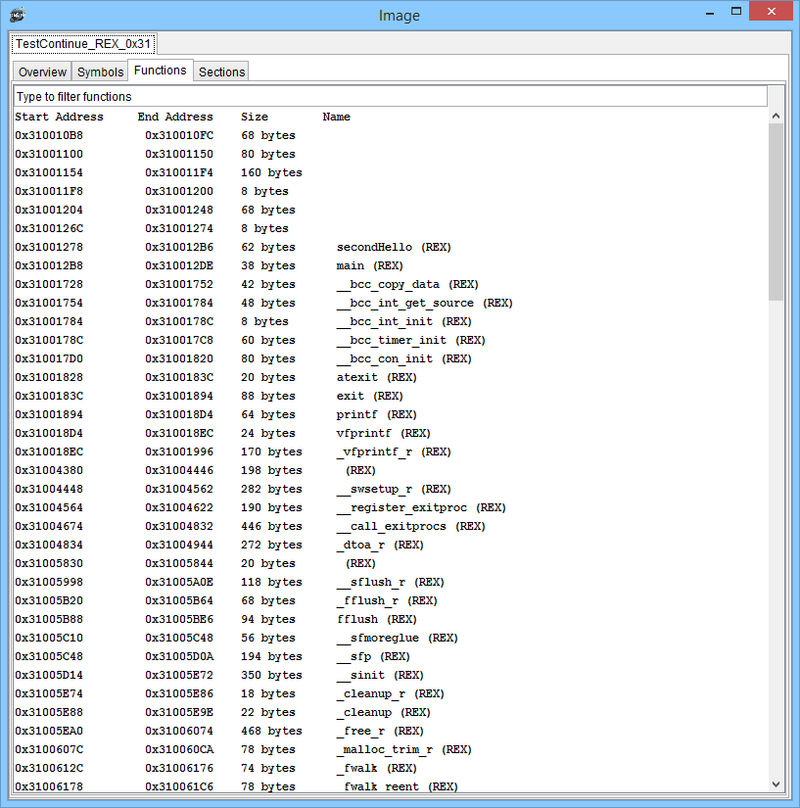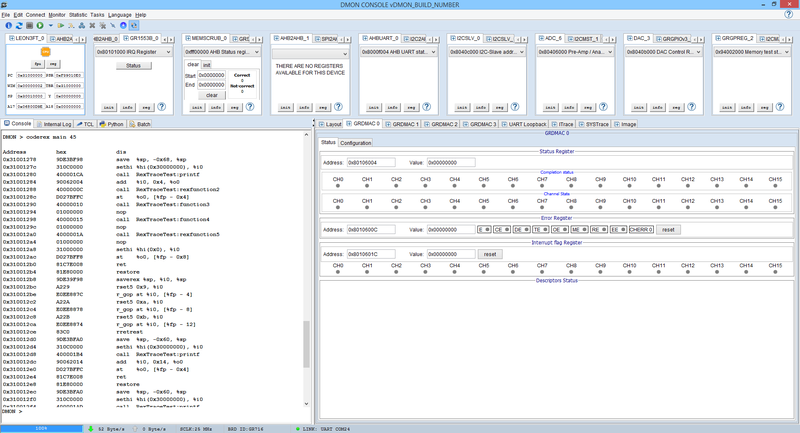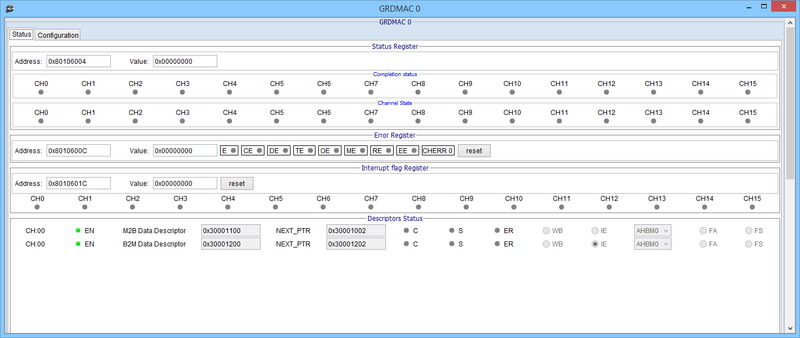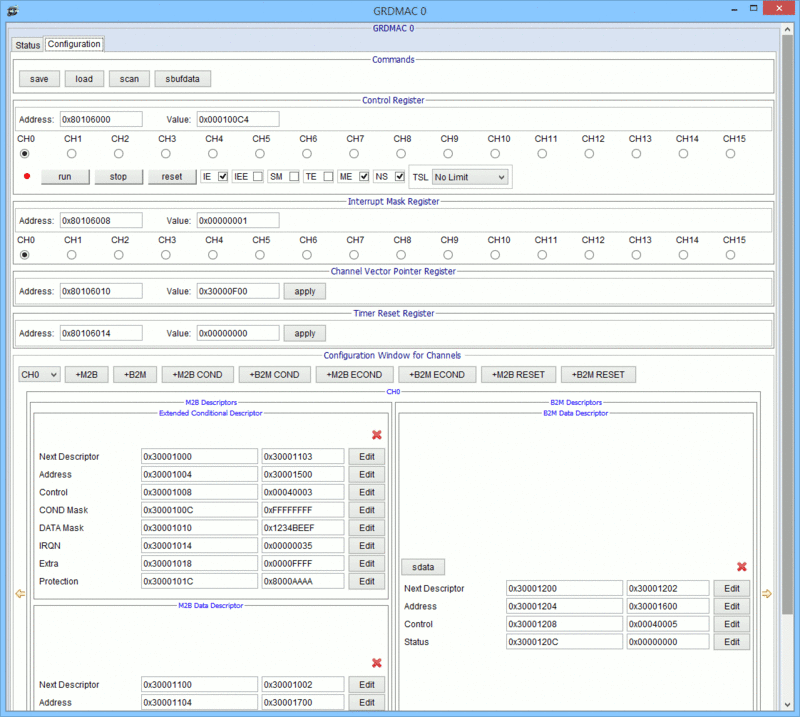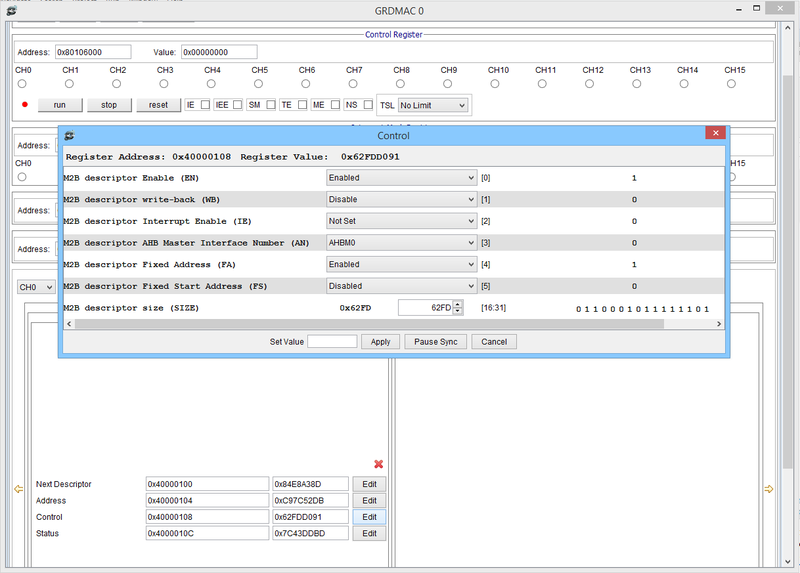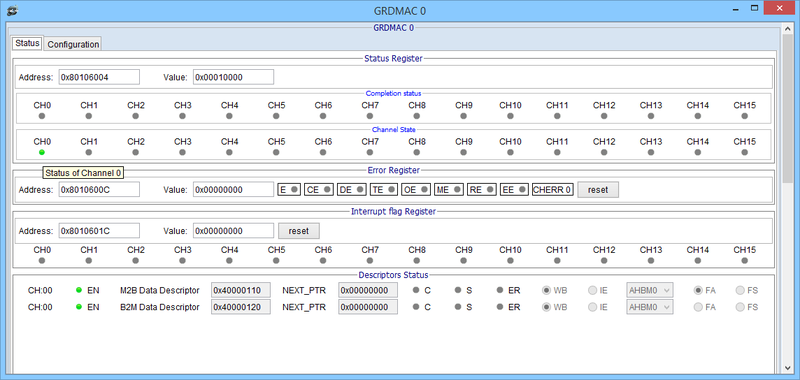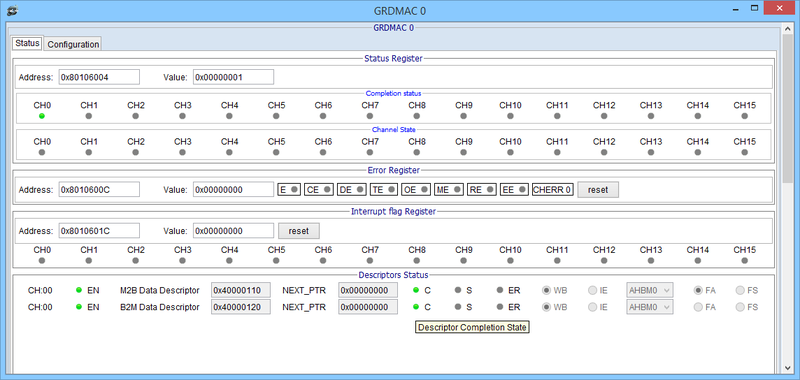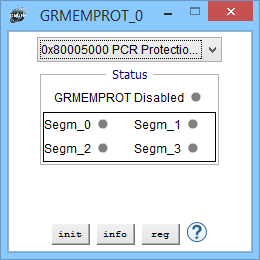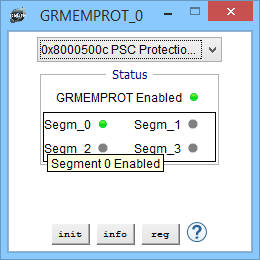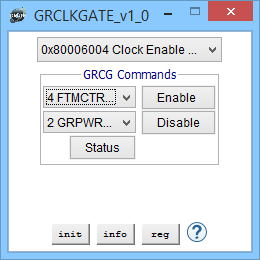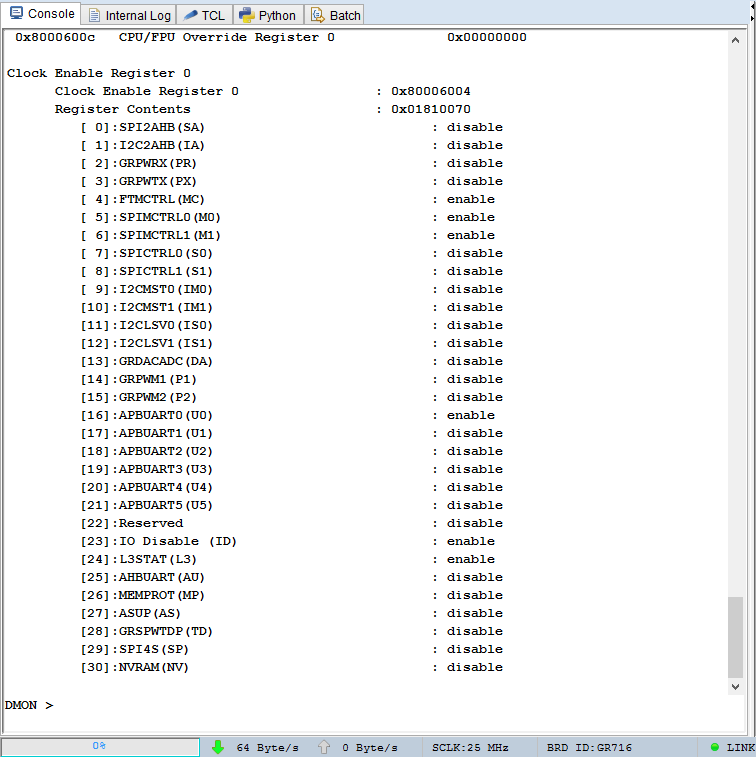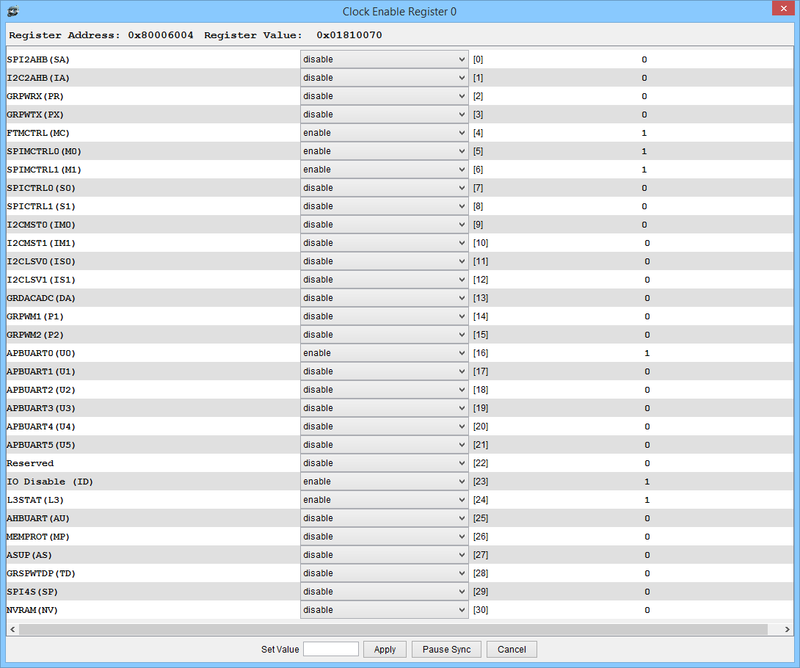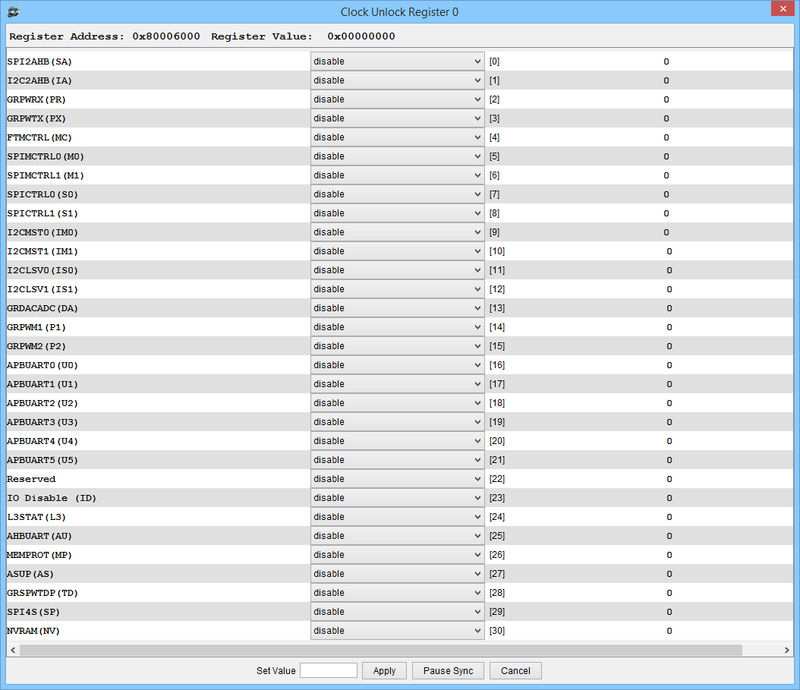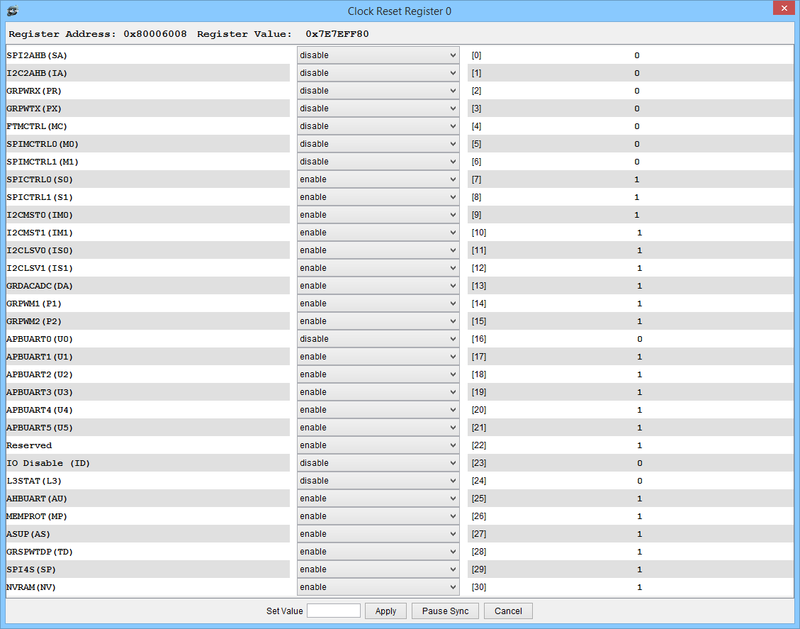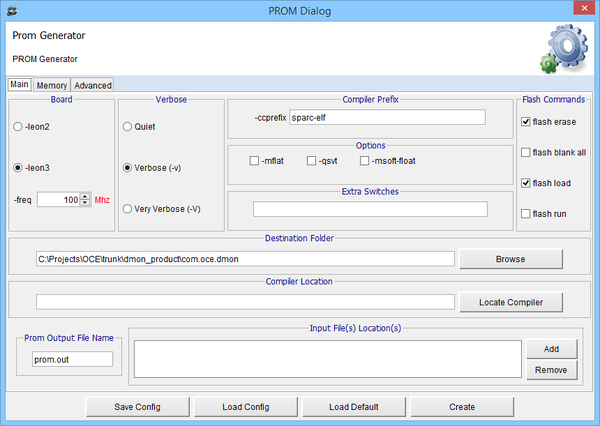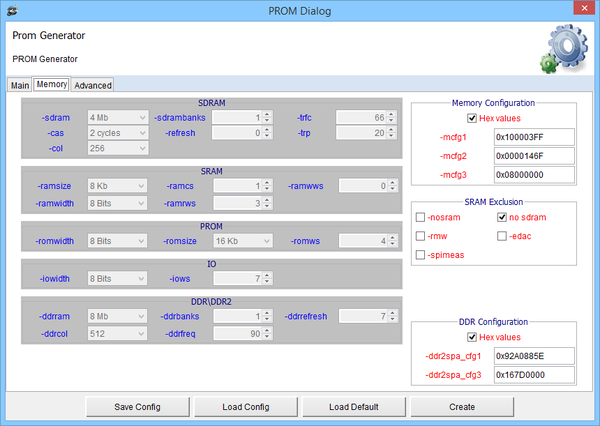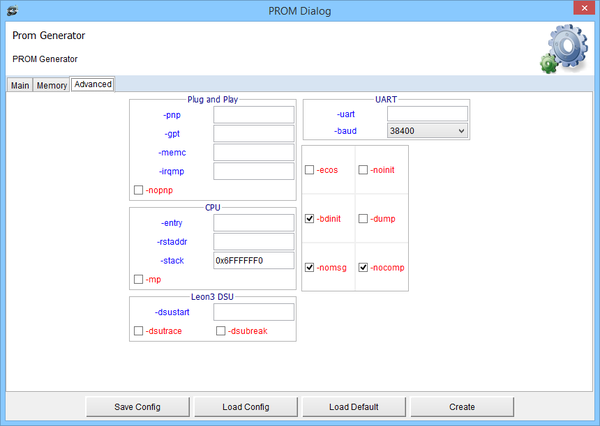Difference between revisions of "DMON SOC support"
imported>Dtimofejevs |
imported>Dtimofejevs |
||
| Line 5: | Line 5: | ||
The following command line options must be passed to DMON for this mode: | The following command line options must be passed to DMON for this mode: | ||
:''-arm'' Start DMON in ARM mode and load ARM specific commands | :''''-arm'''' Start DMON in ARM mode and load ARM specific commands | ||
:''-segger'' Use Segger J-Link | :''''-segger'''' Use Segger J-Link | ||
:''-device STM32L152VB'' specify the device for Segger | :''''-device STM32L152VB'''' specify the device for Segger | ||
:''-swd'' Use the Serial Wire Debug interface (SWD). If not specified then Segger will use JTAG to communicate with the target. The use of SWD is optional but recommended. | :''''-swd'''' Use the Serial Wire Debug interface (SWD). If not specified then Segger will use JTAG to communicate with the target. The use of SWD is optional but recommended. | ||
Some optional switches: | Some optional switches: | ||
:''-svd [file location]'' Set svd file to use for device initialisation. | :''''-svd [file location]'''' Set svd file to use for device initialisation. | ||
:''-rtt'' Enable rtterminal command. Read target output to DMON console. | :''''-rtt'''' Enable rtterminal command. Read target output to DMON console. | ||
:''-jlinkscript [file location]'' Set jlink script file. | :''''-jlinkscript [file location]'''' Set jlink script file. | ||
:''-setresettype [reset type]'' Set reset type, default type is JLINKARM_CM3_RESET_TYPE_NORMAL. | :''''-setresettype [reset type]'''' Set reset type, default type is JLINKARM_CM3_RESET_TYPE_NORMAL. | ||
Revision as of 20:14, 23 August 2021
ARM support
DMON v2 integrates the Segger J Link debug link and adds proof of concept support for a single ARM target - STM32L152VB. The Segger J Link supports a huge number of processors, see https://www.segger.com/jlink_supported_devices.html . DMON2 customers can request support for additional ARM devices.
The following command line options must be passed to DMON for this mode:
- '-arm' Start DMON in ARM mode and load ARM specific commands
- '-segger' Use Segger J-Link
- '-device STM32L152VB' specify the device for Segger
- '-swd' Use the Serial Wire Debug interface (SWD). If not specified then Segger will use JTAG to communicate with the target. The use of SWD is optional but recommended.
Some optional switches:
- '-svd [file location]' Set svd file to use for device initialisation.
- '-rtt' Enable rtterminal command. Read target output to DMON console.
- '-jlinkscript [file location]' Set jlink script file.
- '-setresettype [reset type]' Set reset type, default type is JLINKARM_CM3_RESET_TYPE_NORMAL.
When DMON is started with the appropriate ARM switches information about the link discovered is displayed (as below).
The device configuration for the ARM target is read from an ARM CSMIS SVD file which describes the peripheral devices and their registers. In this version this SVD file is included as part of the built DMON and only this file is loaded and used. The output below shows device and peripheral information.
Name of the device STM32L152VB Core id of the device 0x4BA00477 CPU core CORTEX_M3 Device manufacturer ST Start address of flash area 0x08000000 Start address of RAM area 0x20000000 0=Little, 1=Big, 2=Both 0 Total flash size in bytes 132 KB Total RAM size in bytes 16 KB Flash regions : Start Address: 0x08000000 Size: 128 KB Start Address: 0x08080000 Size: 4 KB RAM regions : Start Address : 0x20000000 Size : 16 KB OEM : IAR Target Voltage = 3.338 V Connected with SWD Identified ::: Cortex-M3 core Target interface speed: 1000 kHz Peripheral Devices: C_ADC Common ADC registers N/A COMP Comparators N/A CRC CRC calculation unit N/A DAC Digital-to-analog converter N/A DMA1 Direct memory access controller N/A EXTI External interrupt/event controller N/A Flash Flash N/A GPIOA General-purpose I/Os N/A GPIOB General-purpose I/Os N/A GPIOC General-purpose I/Os N/A GPIOD General-purpose I/Os N/A GPIOE General-purpose I/Os N/A GPIOH General-purpose I/Os N/A I2C1 Inter-integrated circuit N/A I2C2 Inter-integrated circuit N/A IWDG Independent watchdog N/A LCD Liquid crystal display controller N/A PWR Power control N/A RCC Reset and clock control N/A RI Routing interface N/A RTC Real-time clock N/A SPI1 Serial peripheral interface N/A SPI2 Serial peripheral interface N/A SYSCFG System configuration controller N/A TIM10 General-purpose timers N/A TIM11 General-purpose timers N/A TIM2 General-purpose timers N/A TIM3 General-purpose timers N/A TIM4 General-purpose timers N/A TIM6 Basic timers N/A TIM7 Basic timers N/A TIM9 General-purpose timers N/A USART1 Universal synchronous asynchronous receiver transmitter N/A USART2 Universal synchronous asynchronous receiver transmitter N/A USART3 Universal synchronous asynchronous receiver transmitter N/A USB Universal serial bus full-speed device interface N/A USB_SRAM Universal serial bus full-speed device interface N/A WWDG Window watchdog N/A ADC Analog-to-digital converter N/A NVIC Nested Vectored Interrupt Controller N/A DBG Debug support N/A
The SVD is used create objects for each peripheral device, to build a layout diagram for the SoC with the same functionality as for SPARC devices, and a widget with a drop down list of the registers for each peripheral.
There is also an object and widget for the CPU (see below).
On-chip IP blocks can be selected and their registers viewed and modified through the GUI.
ARM supported DMON commands
When in ARM mode the console supports the following commands:
| Command | Description |
|---|---|
| about | display information about DMON version |
| breakh <addr|symbol> | display breakpoints or add hardware breakpoint |
| breaks <addr|symbol> | display or add software breakpoint |
| clear <num|address> | delete all breakpoints or breakpoint at number or address |
| cls | clear console |
| code <addr|PC> <length> <mode> | Disassemble <length> instructions starting at <address> or current PC using <mode> (ARM or Thumb).Default mode is the currently set mode, this will normally correctly recognise whether the instruction is ARM or Thumb. |
| continue | continue execution |
| datamon load [filename] | load a DataSet from an xml file |
| datamon save [filename] | save the current DataSet to an xml file |
| datamon start | Validate the current DataSet if successful, start monitoring |
| datamon stop | stop monitoring |
| datamon xsd [filename] | save schema for DataSet to the specified file |
| devreg | list available devices |
| devreg <name> | display registers in <name> |
| devreg <name> <regname> | display register detail for <regname> in <name> |
| devreg <name> <regname> <value> | Write <value> to <regname> in <name> |
| devreg <name> list | list register names in <name> |
| dmon | Use only DMON commands. Ignored if already in DMON mode |
| echo [string] | display string in the console (and log file if active) |
| examine [addr] <length> | display memory |
| exec [command] | execute shell command in OS |
| flash erase | erase flash device |
| font | show current font |
| font list | list system fonts |
| font reset | reset the font to the default |
| font set [value] | set font |
| gb2312 | Use GB2312 character set for displaying memory data |
| getb [address] <count> | Returns a byte or array of <count> bytes in the command response (for scripting in Tcl) |
| getstate | returns 1 if an application is running on the target, 0 otherwise. (for scripting in Tcl) |
| getw [address] <count> | Returns a word or array of <count> words in the command response |
| halt | stop program on board |
| help <command> | display commands or command |
| info dev | list devices available for info dev command |
| info dev <name> | display information for device <name> |
| info sys | display basic system information |
| log [file_name] | open log file or create new and output some system information |
| loglevel [level] | set internal logging to level. Possible levels [verbose|restore|info|warn|error] |
| logoff | stop output to file |
| lookup [hex value] | show the ELF symbol matching the hex address |
| lookup [symbol or expression] | show the value of the symbol (internal or ELF) |
| pause -1 | pause script until processor stops |
| pause [duration in ms] | pause script until duration has elapsed or processor stops |
| precont [filename] | append a script to the user scripts executed before continuing/stepping a program |
| precont insert [index] [filename] | insert a script at [index] in the user scripts executed before continuing/stepping a program |
| precont list | list the user scripts executed before continuing/stepping a program |
| precont remove [index|all] | remove the script at [index] in the user scripts or all scripts executed before continuing/stepping a program |
| prerun [filename] | append a script to the user scripts executed before starting a program |
| prerun insert [index] [filename] | insert a script at [index] in the user scripts executed before starting a program |
| prerun list | list the user scripts executed before starting a program |
| prerun remove [index|all] | remove the script at [index] in the user scripts or all scripts executed before starting a program |
| printreg | display system registers |
| python | Interpret command input as Python commands. Ignored if in Python mode |
| quit | exit DMON |
| reg | show values for all available CPU registers |
| reg <name> | show register named |
| reg <name> <value> | write value to register named |
| reg show | show available register names |
| run <pc> | start the CPU from <pc> |
| runscript [filename] | set the user script executed during program execution |
| runscript list | list the user script executed during program execution |
| runscript remove | clear the user script executed during program execution |
| save [addr] [addr] [file] <bin> | dump target memory to file in srecord (or binary) format |
| script [file_name] | execute a batch file of DMON commands |
| setv [label] [expression] | Sets a DMON label to have a 64 bit integer value |
| shell | In a startup script activate the language specified by command line option. Otherwise, display the langauge in use. |
| step <n> | single step one or <n> times |
| stop | Invoked on CTRL-C. Abort DMON command,stop program on board |
| symbols <file> | show/load symbols |
| tcl | Interpret command input as Tcl commands. Ignored if in Tcl mode |
| utf8 | Use UTF-8 character set for displaying memory and UART data |
| watch <addr|symbol> | display all breakpoint or add data watchpoint on read or write |
| watchr <addr|symbol> | display all breakpoint or add data watchpoint on read |
| watchw <addr|symbol> | display all breakpoint or add data watchpoint on write |
| write [addr] [data] <number words> | write one word of data to "number words" starting from addr |
ARM specific commands
The devreg commands are specific to ARM peripherals, and display or modify the registers in a specified peripheral:
DMON > devreg Available devices: ADC COMP CRC C_ADC DAC DBG DMA1 EXTI FLASH GPIOA GPIOB GPIOC GPIOD GPIOE GPIOH I2C1 I2C2 IWDG LCD NVIC PWR RCC RI RTC SPI1 SPI2 SYSCFG TIM10 TIM11 TIM2 TIM3 TIM4 TIM6 TIM7 TIM9 USART1 USART2 USART3 USB USB_SRAM WWDG DMON > devreg gpioe GPIOE 0x40021000 GPIO port mode (MODER) 0x00500000 0x40021004 GPIO port output type (OTYPER) 0x00000000 0x40021008 GPIO port output speed (OSPEEDER) 0x00f00000 0x4002100c GPIO port pull-up/pull-down (PUPDR) 0x00000000 0x40021010 GPIO port input data (IDR) 0x00001000 0x40021014 GPIO port output data (ODR) 0x00000000 0x40021018 GPIO port bit set/reset (BSRR) 0x00000000 0x4002101c GPIO port configuration lock (LCKR) 0x00000000 0x40021020 AFRL (AFRL) 0x00000000 0x40021024 GPIO alternate function high (AFRH) 0x00000000 DMON > devreg gpioe odr 0xffffffff Wrote value 0xffffffff to odr DMON > devreg gpioe GPIOE 0x40021000 GPIO port mode (MODER) 0x00500000 0x40021004 GPIO port output type (OTYPER) 0x00000000 0x40021008 GPIO port output speed (OSPEEDER) 0x00f00000 0x4002100c GPIO port pull-up/pull-down (PUPDR) 0x00000000 0x40021010 GPIO port input data (IDR) 0x00001c00 0x40021014 GPIO port output data (ODR) 0x0000ffff 0x40021018 GPIO port bit set/reset (BSRR) 0x00000000 0x4002101c GPIO port configuration lock (LCKR) 0x00000000 0x40021020 AFRL (AFRL) 0x00000000 0x40021024 GPIO alternate function high (AFRH) 0x00000000
AGGA-4 Support
AGGA-4 hardware
The AGGA-4 (Advanced GPS/GALILEO ASIC) is a radiation tolerant GNSS baseband ASIC capable of processing the modernized GPS and Galileo Signals. Due to its flexibility it is also able to process not only GPS and Galileo but also other GNSS systems like Glonass, Compass, etc. AGGA-4 also incorporates the processor, the communication interfaces and other support functions (e.g. FFT, CRC) inside the ASIC which simplifies the GNSS receiver board design.
The functional blocks are shown in the diagram below.
The GNSS Core (shown below) consists of 4 Input Modules (IM), one Power Level Detector (PLD) Module, two Beam Forming (DBF) Modules, a Time Base Generator (TBG), an Antenna Switch Controller (ASC) and 36 channels.
DMON supports the functional blocks on the AGGA-4 and the specific features below:
- System Visualisation
- Devices present and their state
- Register details/modify
- GNSS
- Configuration Blocks Display and Modify
- Interrupt Configuration
- Power Level
- Channel Configurations
- Overall display
- Set, Copy, Modify, Save and Load
- Dump observables to file
- FFT
- CRC
See below some example screenshots from the tool.
Main AGGA4 console
GNSS on AGGA4 has a lot of Configuration Registers. DMON identifies GNSS as AGGA4_GNSS_FE/CHS dummy device and logically AGGA4_GNSS_FR_END device (IM0, IM1, IM2, IM3 and PLD) and AGGA4_GNSS_CHS device (Channel Matrix, IC, Channels).
Power Level Detector window
Power Level Detector chart
DMON reads PLD Accumulation Registers and Displays as Bar Chart
Channel Matrix Window
Input Module window
Channel Control window
Channel Final Down Converter window
Channel Code Delay Line Unit window
Channel Code Generator Unit window
Channel Correlator Unit window
Channel Aiding Unit window
Channel GNSS DMA window
Channel Status window
Commands
The sections below describe the AGGA-4 commands. The table below is a summary of these commands.
| Command | Description |
|---|---|
| gnss copy <nomem>[ch[#]..ch[n]/all] | copy config from ch# to other space separated channels/all if <nomem> used the RAM code not copied |
| gnss [save/load] ch# file | Save/load Channel Configurations to File as xml |
| gnss dump [start/stop] ch# file | Start/Stop dumping of Channel Observables to File |
| gnss dump reset ch# | Reset dumping of Channel Observables to initial state |
| gnss printreg ch [#] [RegName] | Display Registers/Register for GNSS Channel [number] |
| gnss printreg cm [RegName] | Display Registers/Register for GNSS Channel Matrix |
| gnss printreg ic [RegName] | Display Registers/Register for GNSS Interrupt Controller |
| gnss printreg im [#][RegName] | Display Registers/Register for GNSS Input Module |
| gnss printreg pld [RegName] | Display Registers/Register for GNSS POWER LEVEL DETECTOR |
| gnss setreg ch [#] [RegName/FieldName][val] | Set Register/Bitfield for GNSS Channel [number] |
| gnss setreg cm [RegName/FieldName][val] | Set Register/Bitfield for GNSS Channel Matrix |
| gnss setreg ic [RegName/FieldName][val] | Set Register/Bitfield for GNSS Interrupt Controller |
| gnss setreg im [#][RegName/FieldName][val] | Set Register/Bitfield for GNSS Input Module |
| gnss setreg pld [RegName/FieldName][val] | Set Register/Bitfield for GNSS PLD |
| gnss slave [ch[#] ch[n]/all] | Slave channel/channels from to/all to previous Channel |
| fft <display> | Periodically checks FFT_Done bit and display results, <display> opens up graph panel |
| fft [file in] <optional> | Processes input file in pairs of 128, if output file is omitted then results will be stored .out.csv added to end of [file in]. Possible optional arguments are <file out> <nohex,onlyhex> |
| fft stop | Stops periodically polling |
| crc alias [name][poly][init] <opt> | Creates new alias, option arguments are <xor> <revdata> <revrslt> |
| crc alias display | Display list of aliases in current DMON session |
| crc calculate [bin] <addr> | Calculates crc of bin file, addr argument sets starting address for file |
| crc calculate [elffile] <sections> | Calculates crc of elf file, section argument allows calculation only on that section |
| crc calculate [srec] | Calculates crc of srec file |
| crc calculate [start][end]<init> | Calculates crc of a range of address, if init value is specified then that value will be written to CRCLFSR register before beginning. |
| crc init [alias] | Initialises CRC device with values in alias |
| crc init [ploy][init] <opt> | Initialises CRC device, optional arguments are <xor> <revdata> <revrslt> |
| reset <software/gnss> | Reset system software or gnss software |
| reset set <key> <value> | set the reset key <swen, swex, gnssen, gnssex> with value |
| spwdebug <IP/port> <port> | Change debug link to SpaceWire port |
GNSS commands
DMON > gnss copy nomem ch0 ch1 Configurations from Channel 0 were copied to Channel 1 without RAM DATA DMON > gnss copy ch0 ch1 ch2 Configurations from Channel 0 were copied to Channel 1 Configurations from Channel 0 were copied to Channel 2
Or Alternatively Copy Dialog Window can be used
The user can select Channel, Configuration Registers and Values for exporting to xml file. This file can be loaded later for the same Channel or any other.
DMON > gnss save ch0 MyFile.xml Currently processing XML, please wait Successfully save configuration to C:\Projects\OCE\trunk\dmon_product\com.oce.dmon\MyFile.xml DMON > gnss load ch0 MyFile.xml Processing XML Initialising Registers Successfully initialised registers
Dialog to Save Channel configurations to xml file below.
Dialog to Save GNSS to xml file below.
Dialog to Save AGGA4 specific registers to xml file below.
Dialog to select xml configuration file to be imported below.
DMON > gnss printreg ch 0 AGGA4 GNSS CHANNEL 0 Registers 0xa0000000 channelctrl 0x00000000 0xa0000004 carrswfreq 0x00000000 0xa0000008 carrswshift 0x00000000 0xa000000c codeswfreq ….
DMON > gnss printreg ch 0 channelctrl GNSS Channel #0 Reg :: channelctrl = 0x00000000 Register Contents : 0x00000000 [ 0, 4]:InputSel : first bypass of DBF0 (IM 0) [ 5]:CarrSel : Local [ 6]:CodeSel : Local [ 7]:IntEpochSel : Local [ 8]:TimeBaseSel : Local
DMON > gnss printreg cm AGGA4 GNSS CHANNEL MATRIX Registers : 0xa0240000 chactivation0 0x00000001 0xa0240004 chactivation1 0x00000000 0xa0240008 dbfinputsel 0x00000000 0xa024000c epochclkdiv …
DMON > gnss printreg cm chactivation0 GNSS Channel Matrix Reg :: chactivation0 = 0x00000001 Register Contents : 0x00000001 [ 0]:Channel_0 : enabled [ 1]:Channel_1 : disabled [ 2]:Channel_2 : disabled [ 3]:Channel_3 : disabled [ 4]:Channel_4 : disabled [ 5]:Channel_5 : disabled [ 6]:Channel_6 ….
DMON > gnss printreg ic AGGA4 GNSS Interrupt Controller Registers : 0xa02c0000 gic_mask0 0x00000000 0xa02c0004 gic_mask1 0x00000000 0xa02c0008 gic_prio0 0x00000001 0xa02c000c gic_prio1 0x00000000 0xa02c0010 gic_pend0 0x00000000 0xa02c0014 gic_pend1 0x00000070 0xa02c0018 gic_clear0 0x00000000 0xa02c001c gic_clear1 0x00000000 0xa02c0020 gic_queuelow 0x0000003f 0xa02c0024 gic_queuehigh 0x0000003f 0xa02c0028 gic_queuestatus 0x00000000
DMON > gnss printreg ic gic_mask0 GNSS Interrupt Controller Reg :: gic_mask0 = 0x00000000 Register Contents : 0x00000000 [ 0]:Channel_0 : Pending Register [ 1]:Channel_1 : Pending Register [ 2]:Channel_2 : Pending Register [ 3]:Channel_3 : Pending Register [ 4]:Channel_4 : Pending Register [ 5]:Channel_5 …
DMON > gnss printreg im 0 AGGA4 GNSS Input Module_0 Registers : 0xa0250000 inputmodulectrl 0x00000000 0xa0250004 ddcmainphaseinc 0x00000000 0xa0250008 ddcmainfirquantthres 0x00000000 0xa025000c ddcauxphaseinc 0x00000000 0xa0250010 ddcauxfirquantthres 0x00000000 0xa0250014 dacontrolbitfielddefaultr 0x00000000
DMON > gnss printreg im 0 inputmodulectrl GNSS Input Module #0 Reg :: inputmodulectrl = 0x00000000 Register Contents : 0x00000000 [ 0, 1]:Mode : Input Format Converter Mode (IFC) [ 2, 3]:IFCFormat : Sign/Magnitude [ 4]:DDCMainInSel : local [ 5]:DDCAuxInSel : local
DMON > gnss printreg pld AGGA4 GNSS POWER LEVEL DETECTOR Registers : 0xa02b0000 pld5iinputsel 0x00000000 0xa02b0004 pld5ictrl 0x00000000 0xa02b0008 pldiqinputsel 0x00000000 0xa02b000c pldiqpreaccctrl 0x00000000 0xa02b0010 pldiqctrl 0x00000000 0xa02b0014 acc5iplusseven 0x00000000 0xa02b0018 acc5iplusfive 0x00000000 0xa02b001c acc5iplusthree …
DMON > gnss printreg pld pld5ictrl
GNSS Power Level Detector Reg :: pld5ictrl = 0x00000000 Register Contents : 0x00000000 [ 0,23]:AccTime : 0 [24]:SelectTrigger : latched after AccTime Samples
DMON > gnss setreg cm chactivation0 0xffffffff Value for Register chactivation0 set to 0xFFFFFFFF
DMON > gnss setreg cm chactivation0 Channel_0 0x0 Value for Register chactivation0 set to 0xFFFFFFFE
DMON > gnss slave ch1 Channel 1 was set as Slave
FFT commands
Creating FFT Task through the gui, start by clicking on the menu Tasks>>Configure Tasks.
Find FFT and click create task.
If you don’t enter an output file, then an output file will be generated in the input file directory with the same filename but suffixed with .csv.
The output type can be changed to have all (which includes the hex and float values) or just hex or float. All is set by default.
When the job is running, it will be located in the overview window, when it is done, it will be moved to the history tab. You will be able to see the time it took for the task to run as well as the result. You can click on the log icon to open the log window or alternatively clicking on the x icon deletes the task from history.
Here is the results from the FFT task, as you can see a csv suffix was added to the output file. As well as the results being displayed in the Inphase and Quad phase Panels you will also notice log information for this task.
You can also view the fft information via a line or bar graph by issuing the fft display command.
COMMANDS
fft <display> Periodically checks FFT_Done bit and display results, <display> opens up graph panel
DMON > fft Waiting for Done bit to be set
fft [file in] <optional> Processes input file in pairs of 128, if output file is omitted then results will be stored .out.csv added to end of [file in]. Possible optional arguments are <file out> <nohex|onlyhex>
DMON > fft C: /newline_sep_data_full.txt C: /newline_data_full_output.txt Starting batch processing for FFT Finished processing Batch Number: 1 Finished processing input file\s
DMON > fft C: /newline_sep_data_full.txt C: /newline_data_full_output.txt onlyhex Starting batch processing for FFT Finished processing Batch Number: 1 Finished processing input file\s
DMON > fft C: /newline_sep_data_full.txt C: /newline_data_full_output.txt nohex Starting batch processing for FFT Finished processing Batch Number: 1 Finished processing input file\s
DMON > fft C: /newline_sep_data_fIll.txt C: /newline_data_fill_output.txt Starting batch processing for FFT Finished processing Batch Number: 1 Finished processing Batch Number: 2 Finished processing input file\s
fft stop Stops periodically polling
DMON > fft stop Stopped FFT batch processing
CRC commands
You can create a CRC task by clicking on CRC in the dropdown menu and clicking create task. Here you will be able to set the different properties to be used for generating the CRC.
The results window shows what properties you used to generate the CRC as well as the result and log of the crc task.
COMMANDS
crc alias [name][poly][init] <opt> Creates new alias, option arguments are <xor> <revdata> <revrslt>
DMON > crc alias myAlias 0x3 0x4 0x5 1 1 Successfully added myAlias alias
crc alias display Display list of aliases in current DMON session
DMON > crc alias display Name Polynum Init FinalXOR RevIn RevRes crc16 0x0000A001 0x00000000 0x00000000 true true ccitt 0x00008408 0x0000FFFF 0x00000000 false false crc32 0xEDB88320 0xFFFFFFFF 0xFFFFFFFF true true myAlias 0x00000003 0x00000004 0x00000005 true true
crc calculate [bin] <addr> Calculates crc of bin file, addr argument sets starting address for file
DMON > crc calculate C: /binaryfileAGGA4.bin 0x40000024 Binary File Loading file from address: 0x40000024 Wrote bytes 0% Entry point: 0x40000024 There are no Sections in this file. Calculating CRC for Loaded file Starting CRC Polling CRC Polling complete Checksum is : 0xDCC7C62F
GR716 Support
GR716 Microcontroller
DMON supports the GR716 microcontroller from Cobham-Gaisler. This microcontroller features a fault-tolerant LEON3 SPARC V8 processor, communication interfaces and on-chip ADC, DAC, Power-on-Reset, Oscillator, Brown-out detection, LVDS transceivers, regulators to support for single 3.3V supply, ideally suited for space and other high-rel applications. A block diagram of the GR716 is shown below. DMON provides support for all the functional units on the microcontroller. The sections below provide more information on DMON support for some specific functional units of the microcontroller.
Credit: GR716 User Manual Version 1.26
Startup Options
The table below shows GR716 startup options.
| Command | Description |
|---|---|
| -iomx set [configName configName ...] | Set IOMX configurations for Device or Array of Devices (see IO switch matrix section below) |
| -grcg or grcg_(index) [enable|disable][all|bit..bitN] | Enable|Disable all, single bit or array of bits for GRCLKGATE_(DeviceIndex) (see clock gating section below) |
Typical startup options used with the GR716 Mini development board are
-gui -u -baud 230400 -iomx set mem_gr716_mini_cfg0 -grcg enable 0x4 16 -nosram_1
Layout window
DMON represents the GR716 SOC in the layout below. By clicking on a functional block it's IP and register definitions are displayed in separate windows.
REX support
DMON supports the 16 bit REX instruction set.
DMON Functions View of loaded image (REX functions are marked with (REX))
Instruction Trace Information
DMON > inst 40
Rex Time Address Instruction Result
R 00000008763 3100A170 ld [%i2 + 0x8], %l6 (rld [%i2 + 0x8], %l6) [0000000C]
R 00000008765 3100A174 sub %l6, %i0, %l6 (rsub %i0, %l6) [00000000]
R 00000008766 3100A176 cmp %l6, 0x0 (rcmp %l6, 0x0) [00000000]
R 00000008767 3100A178 add %i5, %i0, %i5 (radd %i0, %i5) [3000005A]
R 00000008768 3100A17A sub %i4, %i0, %i4 (rsub %i0, %i4) [00000000]
R 00000008770 3100A17C st %l6, [%i2 + 0x8] (rst %l6, [%i2 + 0x8]) [3000FEB0][00000000]
R 00000008771 3100A180 bne TestContinue_REX_0x31:__sfvwrite_r + 0x238 (rbne 0xffffff32) [00000000]
R 00000008772 3100A182 add %g0, 0x0, %i0 (rset5 0x0, %i0) [00000000]
R 00000008773 3100A184 ret (rretrest) [3100A181]
R 00000008774 3100A184 restore %i7, 0x8, %g0 (rretrest) [31007E07]
R 00000008777 31007E06 add %g0, %o0, %i0 (rmov %o0, %i0) [00000000]
R 00000008778 31007E08 ba TestContinue_REX_0x31:__sprint_r + 0x74 (rba 0x48) [00000000]
R 00000008781 31007E50 st %i4, [%i2 + 0x8] (rst %i4, [%i2 + 0x8]) [3000FEB0][00000000]
R 00000008783 31007E54 st %i4, [%i2 + 0x4] (rst %i4, [%i2 + 0x4]) [3000FEAC][00000000]
R 00000008784 31007E58 ret (rretrest) [31007E55]
R 00000008785 31007E58 restore %i7, 0x8, %g0 (rretrest) [310042AB]
R 00000008788 310042AA cmp %o0, 0x0 (rcmp %o0, 0x0) [00000000]
R 00000008791 310042AC bne TestContinue_REX_0x31:_vfprintf_r + 0x29d0 (rbne 0x10) [00000000]
R 00000008792 310042AE add %g0, 0x0, %i0 (rset5 0x0, %i0) [00000000]
R 00000008793 310042B0 add %g0, 0xffffff24, %i2 (rset21 0xffffff24, %i2) [FFFFFF24]
R 00000008794 310042B4 ld [%fp + %i2], %i1 (rld [%fp + %i2], %i1) [3000FEAC]
R 00000008797 310042B8 st %i0, [%i1 + 0x0] (rst %i0, [%i1]) [3000FEAC][00000000]
R 00000008798 310042BC add %g0, 0xfffffef8, %i0 (rset21 0xfffffef8, %i0) [FFFFFEF8]
R 00000008800 310042C0 ldd [%fp + %i0], %i4 (rldd [%fp + %i0], %i4) [3000FED4][0000000C]
R 00000008801 310042C4 ba TestContinue_REX_0x31:_vfprintf_r + 0x2a24 (rba 0x4e) [00000000]
R 00000008804 31004312 ldub [%l6 + 0xd], %i0 (rldub [%l6 + 0xd], %i0) [00000089]
R 00000008805 31004316 mov 0x40, %i1 (rone 0x6, %i1) [00000040]
R 00000008806 31004318 and %i1, %i0, %i1 (rand %i0, %i1) [00000000]
R 00000008807 3100431A cmp %i1, 0x0 (rcmp %i1, 0x0) [00000000]
R 00000008810 3100431C bne TestContinue_REX_0x31:_vfprintf_r + 0x2a34 (rbne 0x6) [00000000]
R 00000008811 3100431E add %g0, %i5, %i0 (rmov %i5, %i0) [0000000C]
R 00000008812 31004320 ret (rretrest) [3100431D]
R 00000008813 31004320 restore %i7, 0x8, %g0 (rretrest) [310018D1]
R 00000008816 310018D0 add %g0, %o0, %i0 (rmov %o0, %i0) [0000000C]
R 00000008817 310018D2 ret (rretrest) [310018CF]
R 00000008818 310018D2 restore %i7, 0x8, %g0 (rretrest) [310012D1]
R 00000008822 310012D0 st %o0, [%fp - 0xc] (rst %o0, [%fp - 12]) [3000FF94][0000000C]
R 00000008823 310012D4 call TestContinue_REX_0x31:secondHello (call TestContinue_REX_0x31:secondHello) [310012D1]
00000008825 31001278 saverex %sp, %i0, %sp [3000FED0]
R 00000008826 3100127C ta 0x1 (rset32 TestContinue_REX_0x31:watchData, %i0) [TRAPPED ]
REX Dissembled Instructions
DMON > coderex secondHello Address hex dis 0x31001278 9DE39F98 saverex %sp, %i0, %sp 0x3100127c A3E830000C7C rset32 TestContinue_REX_0x31:watchData, %i0 0x31001282 87EA30000C7C rld32 [TestContinue_REX_0x31:watchData], %o1 0x31001288 83E830000004 rset32 0x30000004, %o0 0x3100128e E0EE887C rst %i0, [%fp - 4] 0x31001292 40000181 call TestContinue_REX_0x31:printf 0x31001296 A23F rset5 0xffffffff, %i0 0x31001298 C4EE807C rld [%fp - 4], %o1 0x3100129c E101 rst %i0, [%o1] 0x3100129e 87E830000028 rset32 0x30000028, %o1 0x310012a4 C0EE8878 rst %o0, [%fp - 8] 0x310012a8 8101 rmov %o1, %o0 0x310012aa 8508 rmov %i0, %o1 0x310012ac 4000017A call TestContinue_REX_0x31:printf 0x310012b0 C0EE8874 rst %o0, [%fp - 12] 0x310012b4 83C0 rretrest 0x310012b6 00009DE3 unimp 0x9de3 0x310012b8 9DE39F98 saverex %sp, %i0, %sp 0x310012bc A220 rset5 0x0, %i0 0x310012be E0EE887C rst %i0, [%fp - 4] 0x310012c2 83E83000004E rset32 0x3000004E, %o0 0x310012c8 E0EE8878 rst %i0, [%fp - 8] 0x310012cc 40000172 call TestContinue_REX_0x31:printf 0x310012d0 C0EE8874 rst %o0, [%fp - 12] 0x310012d4 7FFFFFE9 call TestContinue_REX_0x31:secondHello 0x310012d8 E0EE8078 rld [%fp - 8], %i0 0x310012dc 83C0 rretrest
The table below shows GR716 REX commands:
| Command | Description |
|---|---|
| rex [en|ill|tr]<cpuID> | Sets the REX mode(enable|illegal|transparent) for active cpu or cpuID if provided |
| coderex [addr]<length> <force> | Disassemble REX instructions in memory. DMON will detect if address is in REX block and disassemble as REX. Force switch will bypass detection and disassemble as REX instruction |
| breakrexs [addr]<cpuID> | Force to set REX Software break point. breaks command will scan if address is in REX block and set REX software break point |
DMA Controller
The GR716 microcontroller have 4 separate DMA controller with internal AHB/APB bridge units (GRDMAC). The GRDMAC units described in this section provides a flexible direct memory access controller. The core can perform burst transfers of data between AHB and APB peripherals at aligned or unaligned memory addresses.
One DMA channel per DMA controller is supported. The channel can be configured flexibly by means of two descriptor chains residing in main memory: a Memory to Buffer (M2B) chain and a Buffer to Memory (B2M) chain. Each chain is composed of a linked list of descriptors, where each descriptor specifies an AHB address and the size of the data to read/write, supporting a scatter/gather behavior.
DMON provides a number of specific tabs to allow the user to configure the GRDMAC registers, test DMA transfers, and load/save such test configurations. It is assumed that the user is familiar with the GRDMAC hardware.
GRDMAC status window
GRDMAC configuration window
GRDMAC descriptor configuration
GRDMAC waiting for trigger condition
GRDMAC and Descriptors status after trigger
Available commands for GRDMAC:
| Command | Description |
|---|---|
| grdmac_[devID] b2m add [data|cond|econd] ch[N][addr] | Create B2M data|conditional|extended conditional descriptors at address for Channel |
| grdmac_[devID] b2m remove [data|cond|econd] ch[N] [addr] | Remove B2M descriptor at address for Channel |
| grdmac_[devID] core [en|dis] | Enable(Run) or Disable(Stop) GRDMAC Core |
| grdmac_[devID] core reset | Reset GRDMAC Core to default values |
| grdmac_[devID] ctrl ie [en|dis] | Global Interrupt Enable or Disable |
| grdmac_[devID] ctrl iee [en|dis] | Interrupt Enable or Disable for Errors |
| grdmac_[devID] ctrl me [en|dis] | Extended Mode Enable or Disable |
| grdmac_[devID] ctrl ns [en|dis] | No Starve Mode Enable or Disable |
| grdmac_[devID] ctrl sm [en|dis] | Simplified mode Enable or Disable |
| grdmac_[devID] ctrl te [en|dis] | Timer Enable or Disable |
| grdmac_[devID] ech [en|dis][all|ch# ch#+1] | Set Channel/Channels/All Channels Enabled/Disabled |
| grdmac_[devID] ech [en|dis][ch#-ch#+n] | Set Channel Enabled or Disabled for Range of Channels |
| grdmac_[devID] eirq [en|dis] | Set Interrupt enable for Errors (IEE) |
| grdmac_[devID] error reset | Reset Error Register |
| grdmac_[devID] irq [en|dis] | Set GRDMAC Global Interrupt Enable or Disable (IE) |
| grdmac_[devID] irq [en|dis][all|ch# ch#+1] | Set Interrupt Mask for Channel/Channels/All Channels and Enable Global IRQ |
| grdmac_[devID] irq [en|dis][ch#-ch#+n] | Set Interrupt Mask for Range of Channels and Enable Global IRQ |
| grdmac_[devID] irq reset | Reset Interrupt Flag Register for all channels |
| grdmac_[devID] load [file] | Load GRDMAC configurations from XML file |
| grdmac_[devID] m2b add [data|cond|econd] ch[N] [addr] | Create M2B data|conditional|extended conditional descriptors at address for Channel |
| grdmac_[devID] m2b remove [data|cond|econd] ch[N] [addr] | Remove M2B descriptor at address for Channel |
| grdmac_[devID] save [file] | Save GRDMAC configuration to XML file |
| grdmac_[devID] sbufdata | Display Internal Buffer Readout Area |
| grdmac_[devID] scan | Scan M2B and B2M descriptor linked lists using Channel Vector Pointer |
| grdmac_[devID] sdata [addr] | Print DMA data after successful B2M Descriptor at address |
| grdmac_[devID] set cvp [value] | Set Channel Vector Pointer (CVP) |
| grdmac_[devID] set trv [value] | Set Timer Reset Value (TIMER_RST) |
| grdmac_[devID] status [offset] | Display GRDMAC core status of All registers or at offset (i.e.0x04) to the screen |
| grdmac_[devID] tsl [0|32|64|128] | Set Transfer Size limit (TSL) |
DEMO
Basic GRDMAC Custom Configurations:
Use this link if problems with youtube above
Debugging GRDMAC using DMON
Use this link if problems with youtube above
Sample script:
memset write DLRAM_0_START 0x0 // Set Flag to 0 write 0x40000300 0x0 0x400 // Clear memory write 0x30000004 0xcafebabe 0x400 // Set Data to be transferred grdmac_0 core reset // Reset Core grdmac_0 load config.xml // Load GRDMAC and Descriptors configurations. Copy content of this file and save as config.xml grdmac_0 core en // Start the core write DLRAM_0_START 0x1 // Set Flag to 1 to trigger data descriptor grdmac_0 sdata 0x40000120 // Output transferred data
IO Switch Matrix
The I/O switch matrix provides access to several I/O units. When an interface is not activated, its pins automatically become general purpose I/O. After reset, all I/O switch matrix pins are defined as inputs until programmed otherwise.
Configuration and assigning of functions to external I/O is flexible and is controlled by software via a set of registers.
DMON loads in configuration file iomx.config which located in DMON installation directory C:\Program Files (x86)\DMON\Local
User can modify all those configurations or create new custom that will be loaded when DMON starts.
Then, configuration can be applied using "iomx set name" command when DMON started or "-iomx set name" switch command at DMON initialization.
User can autocomplete configuration names using tab after "iomx set" or display all configurations starting with some combination of letters.
| Command | Description |
|---|---|
| iomx set [configName configName ...] | Set IOMX configurations for Device or Array of Devices |
| -iomx set [configName configName ...] | Switch to set IOMX configurations for Device or Array of Devices, when DMON starts |
| iomx setpin [gpioN][val] | Set IOMX GPIO pin to value |
| iomx show <all|configName> | Display all available IOMX configurations or Search by prefix |
| iomx validate | Validate IOMX configurations |
iomx validate sample output:
DMON > iomx validate GPIO[00] mem_addr_0 GPIO[01] mem_addr_1 GPIO[02] mem_addr_2 GPIO[03] mem_addr_3 GPIO[04] mem_addr_4 GPIO[05] mem_addr_5 GPIO[06] mem_addr_6 GPIO[07] mem_addr_7 GPIO[08] mem_addr_8 GPIO[09] mem_addr_9 GPIO[10] mem_addr_10 GPIO[11] mem_addr_11 GPIO[12] mem_addr_12 GPIO[13] mem_addr_13 GPIO[14] mem_addr_14 GPIO[15] mem_addr_15 GPIO[16] mem_addr_16 GPIO[17] mem_addr_17 GPIO[18] mem_addr_18 GPIO[19] ram_csn_0 GPIO[20] gpio 20 GPIO[21] gpio 21 GPIO[22] gpio 22 GPIO[23] gpio 23 GPIO[24] gpio 24 GPIO[25] mem_data_0 GPIO[26] mem_data_1 GPIO[27] mem_data_2 GPIO[28] mem_data_3 GPIO[29] mem_data_4 GPIO[30] mem_data_5 GPIO[31] mem_data_6 GPIO[32] mem_data_7 GPIO[33] mem_oen GPIO[34] mem_wrn GPIO[35] gpio 35 GPIO[36] gpio 36 GPIO[37] gpio 37 GPIO[38] gpio 38 GPIO[39] gpio 39 GPIO[40] gpio 40 GPIO[41] gpio 41 GPIO[42] gpio 42 GPIO[43] gpio 43 GPIO[44] gpio 44 GPIO[45] gpio 45 GPIO[46] gpio 46 GPIO[47] gpio 47 GPIO[48] gpio 48 GPIO[49] mem_addr_19 GPIO[50] mem_addr_20 GPIO[51] gpio 51 GPIO[52] gpio 52 GPIO[53] gpio 53 GPIO[54] gpio 54 GPIO[55] gpio 55 GPIO[56] gpio 56 GPIO[57] gpio 57 GPIO[58] gpio 58 GPIO[59] gpio 59 GPIO[60] gpio 60 GPIO[61] gpio 61 GPIO[62] gpio 62 GPIO[63] gpio 63
iomx validate sample output with duplicated pin configurations:
DMON > iomx validate GPIO[00] mem_addr_0 GPIO[01] mem_addr_1 GPIO[02] mem_addr_2 GPIO[03] mem_addr_3 GPIO[04] mem_addr_4 GPIO[05] mem_addr_5 GPIO[06] mem_addr_6 GPIO[07] mem_addr_7 GPIO[08] mem_addr_8 GPIO[09] mem_addr_9 GPIO[10] mem_addr_10 GPIO[11] mem_addr_11 GPIO[12] mem_addr_12 GPIO[13] can_tx_0 GPIO[14] can_rx_0 GPIO[15] can_en_0 GPIO[16] mem_addr_16 GPIO[17] mem_addr_17 GPIO[18] mem_addr_18 GPIO[19] ram_csn_0 GPIO[20] gpio 20 GPIO[21] gpio 21 GPIO[22] gpio 22 GPIO[23] gpio 23 GPIO[24] gpio 24 GPIO[25] mem_data_0 GPIO[26] mem_data_1 GPIO[27] mem_data_2 GPIO[28] mem_data_3 GPIO[29] mem_data_4 GPIO[30] mem_data_5 GPIO[31] mem_data_6 GPIO[32] mem_data_7 GPIO[33] mem_oen GPIO[34] mem_wrn GPIO[35] gpio 35 GPIO[36] gpio 36 GPIO[37] can_tx_0 Already mapped GPIO[38] can_rx_0 Already mapped GPIO[39] can_en_0 Already mapped GPIO[40] gpio 40 GPIO[41] gpio 41 GPIO[42] gpio 42 GPIO[43] gpio 43 GPIO[44] gpio 44 GPIO[45] gpio 45 GPIO[46] gpio 46 GPIO[47] gpio 47 GPIO[48] gpio 48 GPIO[49] mem_addr_19 GPIO[50] mem_addr_20 GPIO[51] gpio 51 GPIO[52] gpio 52 GPIO[53] gpio 53 GPIO[54] gpio 54 GPIO[55] gpio 55 GPIO[56] gpio 56 GPIO[57] gpio 57 GPIO[58] gpio 58 GPIO[59] gpio 59 GPIO[60] gpio 60 GPIO[61] gpio 61 GPIO[62] gpio 62 GPIO[63] gpio 63
Memory Protection
The GR716 microcontroller has 2 separate AMBA memory protection units (MEMPROT). The MEMPROT units have the capability to detect and protect memory areas from write accesses. The first memory protection unit (MEMPROT0) is connected to Main AHB bus and the second memory protection unit (MEMPROT1) is connected to the DMA AMBA bus. Each memory protection unit has a unique address for configuration and status. The control and status registers for the memory protection units are located on APB bus in the address range 0x80005000 to 0x80005FFF 0x8010A000 to 0x8010AFFF.
DMON provides the commands below to configure memory protection.
| Command | Description |
|---|---|
| mprot reg | Show GRMEMPRO registers |
| mprot set [n][saddr][eaddr][none|all|g0-g15..] | Protect area [seg num][s address][e address][none|all or array of g0-g15] |
Memory Protection Device View
Memory Protection Device View (enabled)
Clock Gating options
The GR716 microcontroller have 2 separate clock gating units. Each clock gating unit will control its own clock domains and have a unique AMBA address.
The clock gating units provide a means to save power by disabling the clock to unused functional blocks. These cores provide a mechanism to automatically disable the clock to LEON processors in power-down mode, and optionally also to disable the clock for shared floating-point units. The cores also provide a mechanism to reset, enable clock and disable clocks for most functional blocks.
| Command | Description |
|---|---|
| grcg [enable|disable][all|bit..bitN] | Enable|Disable all, single bit or array of bits for GRCLKGATE_0 |
| -grcg [enable|disable][all|bit..bitN] | Switch to Enable|Disable all, single bit or array of bits for GRCLKGATE_0 or -grcg_1 for GRCLKGATE_1, at DMON start up |
| grcg reg | Show register values for GRCLKGATE_0 |
Commands
The table below is a summary of commands specific to the GR716.
| Command | Description |
|---|---|
| breakrexs [addr]<cpuID> | Force to set REX Software break point. breaks command will scan if address is in REX block and set REX software break point |
| coderex [addr]<length> <force> | Disassemble REX instructions in memory. DMON will detect if address is in REX block and disassemble as REX. Force switch will bypass detection and disassemble as REX instruction |
| dlram edac [enable|disable] | Enable|Disable EDAC |
| dlram scrub [enable|disable] | Enable|Disable Scruber |
| gpio pulse status | Show Pulse register for GRGPIO |
| gradcdac config | Display status information for the GRADCDAC core |
| grcan [enable|disable] | Enable|Disable the GRCAN receiver |
| grcan reset | Resets the GRCAN receiver |
| grcan status | Show register values for GRCAN |
| grcan_1 [enable|disable] | Enable|Disable the GRCAN receiver |
| grcan_1 reset | Resets the GRCAN receiver |
| grcan_1 status | Show register values for GRCAN |
| grcg [enable|disable][all|bit..bitN] | Enable|Disable all, single bit or array of bits for GRCLKGATE_0 |
| grcg reg | Show register values for GRCLKGATE_0 |
| grcg_1 [enable|disable][all|bit..bitN] | Enable|Disable all, single bit or array of bits for GRCLKGATE_1 |
| grcg_1 reg | Show register values for GRCLKGATE_1 |
| grdmac_[devID] b2m add [data|cond|econd] ch[N][addr] | Create B2M data|conditional|extended conditional descriptors at address for Channel |
| grdmac_[devID] b2m remove [data|cond|econd] ch[N] [addr] | Remove B2M descriptor at address for Channel |
| grdmac_[devID] core [en|dis] | Enable(Run) or Disable(Stop) GRDMAC Core |
| grdmac_[devID] core reset | Reset GRDMAC Core to default values |
| grdmac_[devID] ctrl ie [en|dis] | Global Interrupt Enable or Disable |
| grdmac_[devID] ctrl iee [en|dis] | Interrupt Enable or Disable for Errors |
| grdmac_[devID] ctrl me [en|dis] | Extended Mode Enable or Disable |
| grdmac_[devID] ctrl ns [en|dis] | No Starve Mode Enable or Disable |
| grdmac_[devID] ctrl sm [en|dis] | Simplified mode Enable or Disable |
| grdmac_[devID] ctrl te [en|dis] | Timer Enable or Disable |
| grdmac_[devID] ech [en|dis][all|ch# ch#+1] | Set Channel/Channels/All Channels Enabled/Disabled |
| grdmac_[devID] ech [en|dis][ch#-ch#+n] | Set Channel Enabled or Disabled for Range of Channels |
| grdmac_[devID] eirq [en|dis] | Set Interrupt enable for Errors (IEE) |
| grdmac_[devID] error reset | Reset Error Register |
| grdmac_[devID] irq [en|dis] | Set GRDMAC Global Interrupt Enable or Disable (IE) |
| grdmac_[devID] irq [en|dis][all|ch# ch#+1] | Set Interrupt Mask for Channel/Channels/All Channels and Enable Global IRQ |
| grdmac_[devID] irq [en|dis][ch#-ch#+n] | Set Interrupt Mask for Range of Channels and Enable Global IRQ |
| grdmac_[devID] irq reset | Reset Interrupt Flag Register for all channels |
| grdmac_[devID] load [file] | Load GRDMAC configurations from XML file |
| grdmac_[devID] m2b add [data|cond|econd] ch[N] [addr] | Create M2B data|conditional|extended conditional descriptors at address for Channel |
| grdmac_[devID] m2b remove [data|cond|econd] ch[N] [addr] | Remove M2B descriptor at address for Channel |
| grdmac_[devID] save [file] | Save GRDMAC configuration to XML file |
| grdmac_[devID] sbufdata | Display Internal Buffer Readout Area |
| grdmac_[devID] scan | Scan M2B and B2M descriptor linked lists using Channel Vector Pointer |
| grdmac_[devID] sdata [addr] | Print DMA data after successful B2M Descriptor at address |
| grdmac_[devID] set cvp [value] | Set Channel Vector Pointer (CVP) |
| grdmac_[devID] set trv [value] | Set Timer Reset Value (TIMER_RST) |
| grdmac_[devID] status [offset] | Display GRDMAC core status of All registers or at offset (i.e.0x04) to the screen |
| grdmac_[devID] tsl [0|32|64|128] | Set Transfer Size limit (TSL) |
| grpwm <dev#> enable|disable | Enable or Disable the GRPWM core |
| grpwm <dev#> status | Display status information for the GRPWM core |
| grpwrx [enable|disable] | Enable|Disable the GRPWRX reciever |
| grpwrx dma [enable|disable] | GRPWRX dma Enable|Disable |
| grpwrx reset | Resets the GRPWRX reciever |
| grpwrx status | Show register values for GRPWRX |
| grpwtx [enable|disable] | Enable|Disable the GRPWTX reciever |
| grpwtx dma [enable|disable] | GRPWTX DMA Enable|Disable |
| grpwtx reset | Resets the GRPWTX Transmitter |
| grpwtx status | Show register values for GRPWTX |
| i2c2ahb enable|disable | Enable or Disable the I2C2AHB core |
| i2c2ahb irq enable|disable | Display status information for the I2C2AHB core |
| i2c2ahb status | Display status information for the I2C2AHB core |
| ilram edac [enable|disable] | Enable|Disable EDAC |
| ilram scrub [enable|disable] | Enable|Disable Scruber |
| iomx set [configName configName ...] | Set IOMX configurations for Device or Array of Devices |
| iomx setpin [gpioN][val] | Set IOMX GPIO pin to value |
| iomx show <all|configName> | Display all available IOMX configurations or Search by prefix |
| iomx validate | Validate IOMX configurations |
| l3stat clear [cnt] | Clear the counter cnt |
| l3stat display [workers/counters] <all|n> | Display information on workers or counters |
| l3stat duration [cnt][enable|disable]<lvl> | If Enabled the core will save the maximum time the selected event has been at the level specified by the EL field if level(lvl) is present the counter will count the cycles, otherwise will count the time between event assertions |
| l3stat events | Show all events that can be selected/counted |
| l3stat events [hex][abbr][descr] | Add new event to DMON (hardware must support this code). hex->code value, abbr->abbreviation, descr->description |
| l3stat poll [cnt][int]<hold><save> | Continuously poll counter(cnt) at interval(int)(min value 100 ms). If hold parameter is passed DMON will poll for Counter control register till software enables the counter and only then will start to poll for counter value. If save parameter is used, DMON will save data to csv file |
| l3stat runpoll [cnt][int]<save> | Poll counter(cnt) at interval(int)(min value 100 ms) while application is running. DMON will start polling when program starts running on the board. If breakpoint is hit, DMON will pause polling and resume after program will continue. If save parameter is used, DMON will save data to csv file |
| l3stat set [cnt][flag=value] | Count the event using counter cnt on processor cpu. Use enable flag(en) the last Available flags: cpu=val, event=val, cl=1|0, su=0|1|2, en=1|0 |
| l3stat status | Display status of all available counters |
| l3stat stop [cnt|all] | Stop polling of Counter Register for counter(cnt) or all and disable counter |
| l3stat_1 clear [cnt] | Clear the counter cnt |
| l3stat_1 display [workers/counters] <all|n> | Display information on workers or counters |
| l3stat_1 duration [cnt][enable|disable]<lvl> | If Enabled the core will save the maximum time the selected event has been at the level specified by the EL field if level(lvl) is present the counter will count the cycles, otherwise will count the time between event assertions |
| l3stat_1 events | Show all events that can be selected/counted |
| l3stat_1 events [hex][abbr][descr] | Add new event to DMON (hardware must support this code). hex->code value, abbr->abbreviation, descr->description |
| l3stat_1 poll [cnt][int]<hold><save> | Continuously poll counter(cnt) at interval(int)(min value 100 ms). If hold parameter is passed DMON will poll for Counter control register till software enables the counter and only then will start to poll for counter value. If save parameter is used, DMON will save data to csv file |
| l3stat_1 runpoll [cnt][int]<save> | Poll counter(cnt) at interval(int)(min value 100 ms) while application is running. DMON will start polling when program starts running on the board. If breakpoint is hit, DMON will pause polling and resume after program will continue. If save parameter is used, DMON will save data to csv file |
| l3stat_1 set [cnt][flag=value] | Count the event using counter cnt on processor cpu. Use enable flag(en) the last Available flags: cpu=val, event=val, cl=1|0, su=0|1|2, en=1|0 |
| l3stat_1 status | Display status of all available counters |
| l3stat_1 stop [cnt|all] | Stop polling of Counter Register for counter(cnt) or all and disable counter |
| mprot reg | Show GRMEMPRO registers |
| mprot set [n][saddr][eaddr][none|all|g0-g15..] | Protect area [seg num][s address][e address][none|all or array of g0-g15] |
| rex [en|ill|tr]<cpuID> | Sets the REX mode(enable|illegal|transparent) for active cpu or cpuID if provided |
| spi2ahb enable|disable | Enable or Disable the SPI2AHB core |
| spi2ahb irq enable|disable | Enable or disable interrupts for SPI2AHB core |
| spi2ahb status | Display status information for the SPI2AHB core |
| spislave status | Show registers values for SPI4SPACE |
| spislave reset | Reset SPI4SPACE device |
| spim edac <enabled|disable> | Enable or Disable EDAC in SPIMCTRL |
| spwtdp status | Display status information for the SPWTDP core |
PROM Builder
DMON PROM Builder Introduction
DMON Prom Builder can be used to configure basic prom settings, create prom file and use DMON commands to load to the target flash. This feature is available in DMON 2.1.0.0 version.
Prom Builder Features:
- Save configurations to the property file
- Load saved configurations
- DMON is displaying current target memory settings for mkprom2 memory switches
- Easy to set basic prom configurations
- Prom Builder is creating make file, which can be examined and used on its own through DMON "buildprom" command or called directly from CLI with make utility
- Prom Builder is calling DMON flash commands after prom file was created to erase flash, check if blank, load prom file to target flash and start program on the board
DMON provides two prom configuration files for E698PM. They located in DMON install directory at DMON\Files\PROM_PM_CONFIG initially and copied to DMON user folder C:\Users\UserName\DMON\PromConfig when Prom Builder is started for the first time. 698PM_RAM_PROM.properties file has configurations that can be used to produce prom file to use RAM only as it does not initialize DDR2 RAM. 698PM_DDR_PROM.properties file has configurations to produce prom file to use DDR2 RAM on E698PM. Sample bdinit.c file is located in DMON\Files\PROM_PM_CONFIG directory. This file has to be compiled and put in the same directory where make file will be stored. bdinit.c can be copied from bdinit.c too.
Please follow the tutorials below. The sample program for E698PM used in tutorials can be found here.
DMON Prom Builder can be called from DMON menu => Tasks => Prom Builder.
DMON Prom Builder Main View:
DMON Prom Builder Memory View:
DMON Prom Builder Advanced View:
DMON Commands
| Command | Description |
|---|---|
| buildprom <cmderase,cmdblank,cmdload,cmdrun> mkf | Create prom by calling mkf in make utility. Pass flash commands as parameters. buildprom cmderase cmdload cmdrun my_make_file |
DMON PROM Builder Tutorials
Creating sample prom file using RAM only:
Use this link if problems with youtube above
Creating prom file to be used with DDR2 RAM:
Use this link if problems with youtube above
Building PROM file using make:
Use this link if problems with youtube above
Creating prom file calling directly mkprom2 from CLI:
